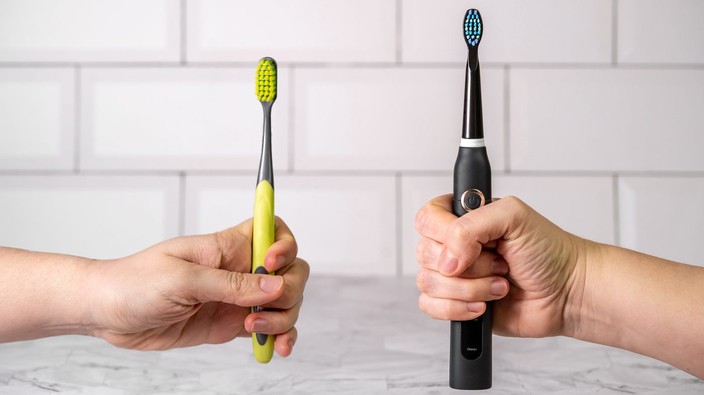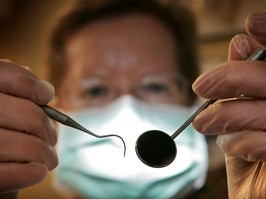electric vs. manual: does it really matter what type of toothbrush you use?
does opting to go manual as opposed to using an electric toothbrush mean your teeth are missing out on the kind of sparkly whites you see in toothpaste commercials?

when it comes to electric or manual toothbrushes, considering factors like consistency, price and efficiency is the priority. getty
i’ve always been a fan of the manual toothbrush. maybe out of convenience, maybe because of the cost, or maybe i just like my purple toothbrush. plus, my dentist never complains.
but i sometimes wonder if opting to go manual as opposed to upping my oral hygiene routine to include an electric toothbrush means that i am missing out (or my teeth are) on the kind of sparkly whites you see in toothpaste commercials.
there’s lots to like about both types of tooth-brushing tools, but is one better than the other?
the pros and cons of a manual toothbrush
price. there’s no doubt who the winner is when it comes to price point. most manual toothbrushes are priced from $0.99 to $15 and only need to be replaced every three to four months or until the bristles start to wear down, flatten out and become less effective. that means you can really splurge on the high-end brush and still spend less than $45 each year.
accessibility. this might not be the top of some people’s list when choosing a brush, but manual brushes often have slim handles that can be harder for people with certain conditions such as arthritis or carpal tunnel to use.
in fact, a study done by the journal for the american geriatrics society found that dexterity was directly linked to oral self-care — a brush that’s harder to use means worse oral hygiene for people who struggle with the ability to grip.
advertisement
manual toothbrushes are very easy to get, however. you can buy a toothbrush at any drugstore, gas station or convenience store. they are also easy to travel with, can be used anywhere and are more sustainable than electric brushes.
effectiveness. efficacy is where the manual brush falls behind its buzzing counterpart. manual toothbrushes simply aren’t as good at removing plaque and cleaning teeth as electric brushes because they rely on the person using the brush to do the job properly, every time. and the fact is, most people aren’t good enough brushers to mimic what an electric brush can do. there is also evidence suggesting that people who use manual toothbrushes brush harder, which can lead to damaged gums and teeth.
electric toothbrushes pros and cons
price. the cost of electric toothbrushes is one of the major cons as it can be prohibitive. while some models can be found for as little as $10, most start around $60 and can go as high as $500. replacement heads for electric brushes can also be pricey depending on which model you have, and they aren’t always easy to find.
accessibility. while electric brushes may be the preferred brush for people who have trouble with dexterity, they aren’t as easy to get as a manual brush, often needing to be purchased at specific stores or online.
advertisement
electric brushes are also clunkier and more difficult to travel with. aside from taking up more space if you have a model that requires a base or has a large case, plugging in your brush might not be easy in some parts of the world.
efficacy. when it comes to which brush actually cleans your teeth more effectively, the electric toothbrush is the winner. a 2014 review of studies on electric brushes versus manual brushes which studied 56 clinical trials that included more than 5,000 adults and children and found a notable gap between the efficacy of the two types of brushes.
“there was an 11 per cent reduction in plaque at one to three months of use, and a 21 per cent reduction in plaque when assessed after three months of use,” researchers wrote. “for gingivitis, there was a six per cent reduction at one to three months of use and an 11 per cent reduction when assessed after three months of use.”
the same study found that the type of electric brush you use also makes a big difference. oscillating head brushes where the head rotates in both directions were more effective than sonic electric brushes that vibrate and move side to side.
other standout features. many electric toothbrushes also come with added features that help you up your oral hygiene with apps or ai technology that measure brushing habits, track how you’re brushing, and offer suggestions on where your technique may be falling short.
advertisement
the bottom line
while electric brushes certainly can be more effective at cleaning teeth and protecting gums, whether you use one or not depends on many factors, including budget. but more importantly, what you choose to put in your mouth really depends on preference. in fact, according to dr. thomas j. salinas, good oral hygiene is less about the brush, and more about frequency and good habits.
“whether you choose an electric toothbrush or a manual toothbrush, remember that what’s most important is daily brushing and flossing,” he says.
nick beare is a toronto-based writer.
thank you for your support. if you liked this story, please send it to a friend. every share counts.
 4 minute read
4 minute read





